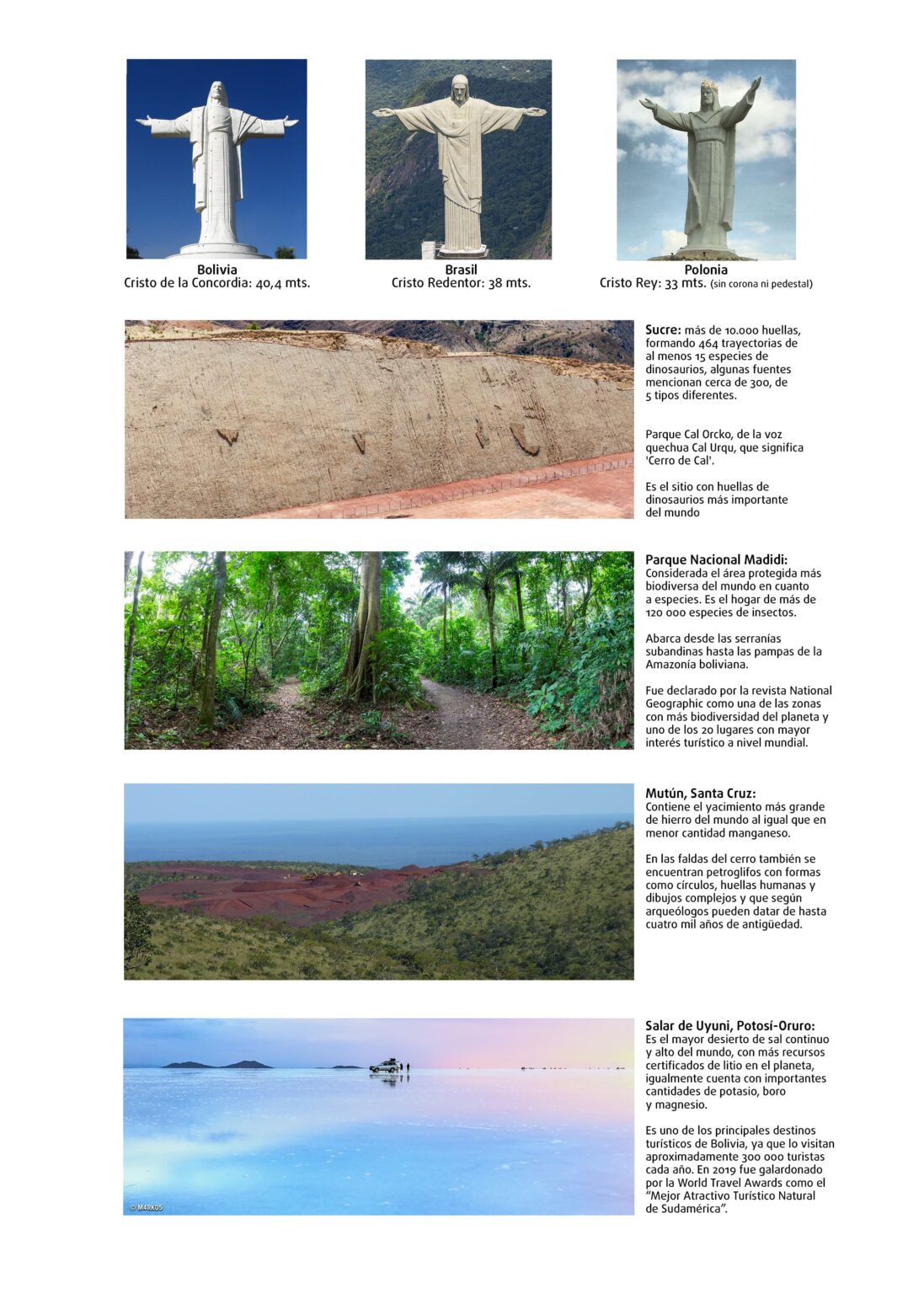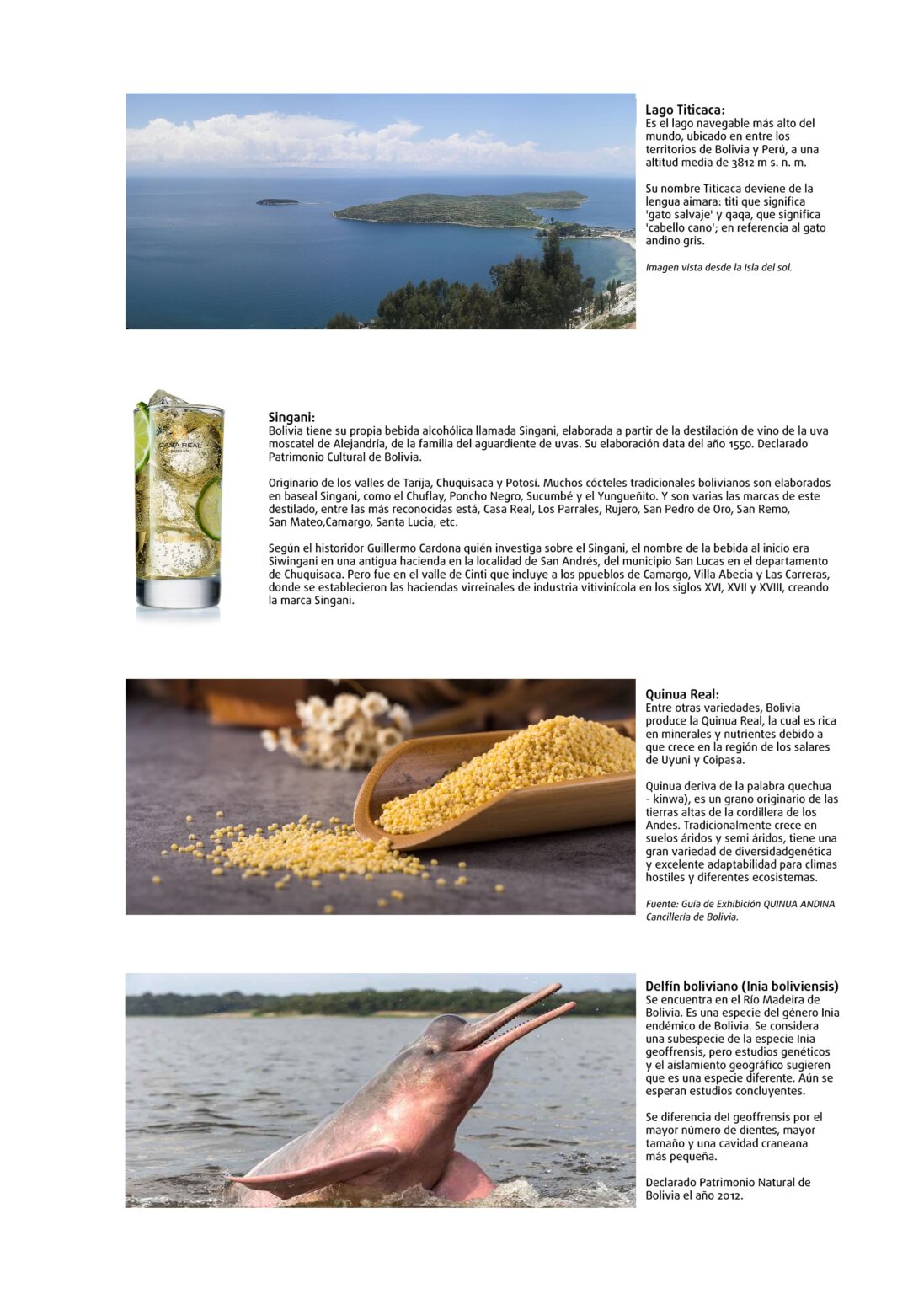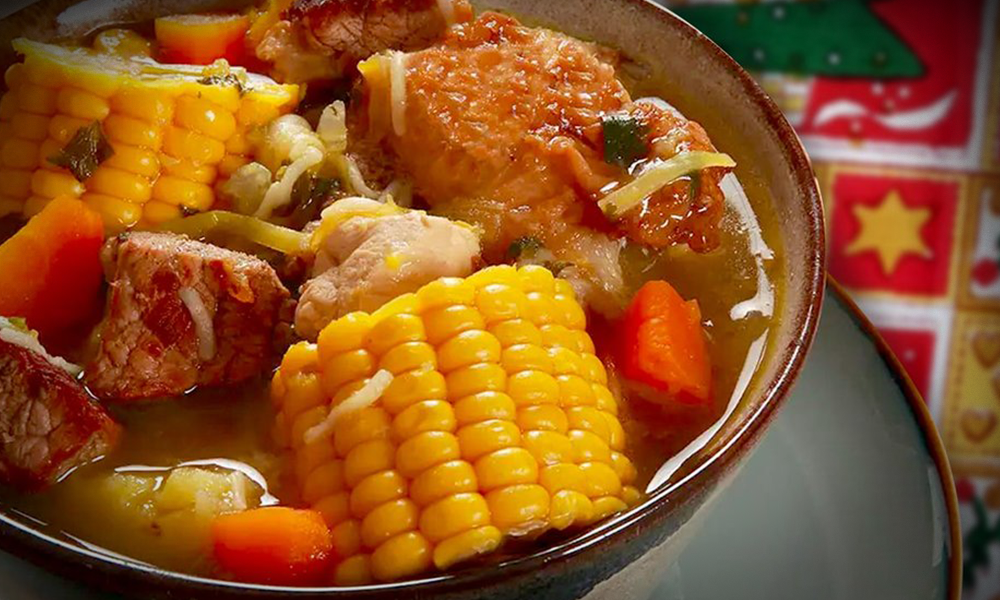Dato 1: El Cristo de la Concordia de Cochabamba es la escultura de Cristo más grande en el mundo, con 40,4 mts. de altura, sobrepasando al Cristo Redentor de Río de Janeiro de 38 mts. y al Cristo de Polonia de 33 mts. (sin pedestal ni corona).
Dato 2: Tiene el mayor parque de huellas de dinosaurios del mundo (Parque Natural Farallón de Cal Orcko en Sucre). Reúne más de 10.000 huellas de dinosaurios, un hallazgo en 2015, desplazando a Alemania que reunía 220 huellas.
Dato 3: Posee el área protegida con mayor biodiversidad en flora y fauna del mundo. Conocido como Parque nacional Madidi, al noreste del departamento de La Paz. Donde se vienen descubriendo nuevas especies.
Dato 4: El Cerro Mutún en el departamento de Santa Cruz, contiene el yacimiento más grande de hierro del mundo. En las faldas del cerro también se encuentran petroglifos con formas como círculos, huellas humanas y dibujos complejos y que según arqueólogos de hasta cuatro mil años de antigüedad.
Dato 5: Es el país con más recursos certificados de litio en el planeta, con 21 millones de toneladas en el Salar de Uyuni, según el Servicio Geológico de Estados Unidos (USGS) el 2020, desplazando a Argentina, que ocupaba esa posición hasta 2019. El Salar es además un hito turístico de renombre, atrayendo a visitantes de todo el mundo por su belleza surrealista.
Dato 6: Tiene el lago navegable más alto del mundo (Titicaca), ubicado en entre los territorios de Bolivia y Perú, a una altitud media de 3812 m s. n. m.
Dato 7: Bolivia tiene su propia bebida alcohólica llamada Singani, elaborada a partir de la destilación de vino de la uva moscatel de Alejandría. Originario de los valles de Tarija y Chuquisaca.
Dato 8: Bolivia es el único país productor mundial de Quinua Real, producida a más de 3.500 m.s.n.m. en la zona del intersalar, en la parte sur del altiplano boliviano, se diferencia de otras variedades de quinua por el grano de mayor tamaño, espesor, color y atributos nutricionales.
Dato 9: El delfín rosado, Inia boliviensis, es una de las especies cetáceo que existe sólo en los ríos de la región amazónica de Bolivia, en los departamentos de Beni, Santa Cruz y Pando, en las sub-cuencas de los ríos Madera, Mamoré e Itenez. Declarado patrimonio natural el 2012.
Dato 10: El nombre Bolivia está vinculado a la figura de Simón Bolívar, tras obtener su independencia en 1825, los líderes del movimiento decidieron honrar a Simón Bolívar dando el nombre de Bolivia al nuevo país, como muestra de respeto y reconocimiento a su liderazgo y contribución a la emancipación de América Latina.

Did you know these facts about bolivia?
Fact 1: The Cristo de la Concordia in Cochabamba city is the largest sculpture of Christ in the world, with 40.4 meters high, surpassing the Christ the Redeemer of Rio de Janeiro which is 38 meters long. and the Christ of Poland with 33 meters. (without the pedestal or crown).
Fact 2: It has the largest park of dinosaur footprints in the world (Farallón de Cal Orcko Natural Park in Sucre). It brings together more than 10,000 dinosaur footprints, a finding in 2015, displacing Germany, which had 220 footprints.
Fact 3: It has the protected area with the greatest biodiversity in flora and fauna in the world. Known as Madidi National Park, northeast of the department of La Paz. Where new species are being discovered.
Fact 4: Cerro Mutún in the department of Santa Cruz contains the largest iron deposit in the world. On the slopes of the hill there are also petroglyphs with shapes such as circles, human footprints and complex drawings that, according to archaeologists, are up to four thousand years old.
Fact 5: It is the country with the most certified lithium resources on the planet, with 21 million tons in Uyuni Salt Flats, according to the United States Geological Survey (USGS) in 2020, displacing Argentina, which held that position until 2019 The Salt flat is also a renowned tourist landmark, attracting visitors from all over the world for its surreal beauty.
Fact 6: It has the highest navigable lake in the world (Titicaca), located between the territories of Bolivia and Peru, at an average altitude of 3812 m above the sea level
Fact 7: Bolivia has its own alcoholic beverage called Singani, made from the distillation of wine from the Muscat of Alexandria grape. Originally from the valleys of Tarija and Chuquisaca.
Fact 8: Bolivia is the only producer of Quinua Real in the world, grown at more than 3,500 meters above sea level. In the intersalar zone, in the southern part of the Bolivian altiplano, it differs from other quinoa varieties due to its larger grain, thickness, color, and nutritional attributes.
Fact 9: The pink dolphin, Inia boliviensis, is one of the cetacean species that only exists in the rivers of the Bolivian Amazon region, in the departments of Beni, Santa Cruz and Pando, in the sub-basins of the Madera, Mamore and Itenez rivers, declared as natural heritage in 2012.
Fact 10: Bolivia´s name is linked to the figure of Simón Bolívar, after obtaining its independence in 1825, the leaders of the movement decided to honor Simón Bolívar by giving the name of Bolivia to the new country, as a sign of respect and recognition of his leadership and contribution to the emancipation of Latin America.





